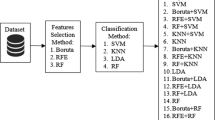Abstract
This paper develops a solution for the problem of the low accuracy on signal modulation type recognition of the weak primary users in low signal-to-noise ratio, a novel signal recognition method based on dimensionality reduction and random forest (RF) is proposed. Firstly, the kernel principal component analysis (KPCA) is applied to extract the most discriminate feature vector. Secondly, the detecting signal is classified by the trained random forest. Performance evaluation is conducted through simulations, and the results reveal the benefits of adopting the proposed algorithm comparing with support vector machine (SVM) and PCA-SVM algorithms.
Access this chapter
Tax calculation will be finalised at checkout
Purchases are for personal use only
Preview
Unable to display preview. Download preview PDF.
Similar content being viewed by others
References
Wang, B., Liu, K.J.R.: Advances in cognitive radio networks: A survey. IEEE Journal of Selected Topics in Signal Processing 5(1), 5–23 (2011)
Sun, H., Nallanathan, A., Wang, C.X., et al.: Wideband spectrum sensing for cognitive radio networks: a survey. IEEE Journal of Wireless Communications 20(2), 74–81 (2013)
Wang, M.M., Li, S.Y., Xiao, S.Y., et al.: Cognitive Radio Spectrum Sensing Algorithm Based on Improved D-S Evidence Theory. Telecommunication Engineering 52(8), 1303–1307 (2012)
Zhao, Q., Geirhofer, S., Tong, L., et al.: Opportunistic spectrum access via periodic channel sensing. IEEE Trans. Signal Process 56(2), 785–796 (2008)
Wang, X., Wang, J.K., Liu, Z.G., et al.: Spectrum sensing algorithm based on random forest in cognitive network. Chinese Journal of Scientific Instrument 34(11), 35–41 (2013)
Zhang, H., Bao, Z., Zhang, S.: Adaptive spectrum sensing algorithm based on cyclostationary spectrum Energy. Journal on Communications 32(11), 95–102 (2011)
Sutton, P.D., Nolan, K.E., Doyle, L.E.: Cyclostationary signatures in practical cognitive radio applications. IEEE Journal of Selected Areas in Communications 26(1), 13–24 (2008)
Bkassiny, M., Li, Y., Jayaweera, S.: A Survey on Machine-Learning Techniques in Cognitive Radios. IEEE Journal of Communications Surveys & Tutorials 45(5), 1–24 (2012)
Vapnik, V.N.: Statistical Learning Theory. Wiley, New York (1998)
Hu, H., Song. J., Wang, Y.: Signal classification based on spectral correlation analysis and SVM in cognitive radio. In: The 22nd International Conference on Advanced Information Networking and Applications (AINA 2008), Okinawa, Japan, pp. 883–887 (March 2008)
Scholkopf, B., Smola, A., Muller, K.: Nonlinear component analysis as a kernel eigenvalue problem. Neural Computation 10(5), 1299–1319 (1998)
Breiman, L.: Random forests. Machine Learning 45, 5–32 (2001)
Author information
Authors and Affiliations
Editor information
Editors and Affiliations
Rights and permissions
Copyright information
© 2014 Springer International Publishing Switzerland
About this paper
Cite this paper
Wang, X. et al. (2014). A Signal Modulation Type Recognition Method Based on Kernel PCA and Random Forest in Cognitive Network. In: Huang, DS., Jo, KH., Wang, L. (eds) Intelligent Computing Methodologies. ICIC 2014. Lecture Notes in Computer Science(), vol 8589. Springer, Cham. https://doi.org/10.1007/978-3-319-09339-0_53
Download citation
DOI: https://doi.org/10.1007/978-3-319-09339-0_53
Publisher Name: Springer, Cham
Print ISBN: 978-3-319-09338-3
Online ISBN: 978-3-319-09339-0
eBook Packages: Computer ScienceComputer Science (R0)




